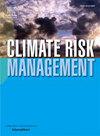社会反应行为揭示抗旱能力的增强与丧失——以清代四川为例
IF 5
2区 环境科学与生态学
Q1 ENVIRONMENTAL SCIENCES
引用次数: 0
摘要
揭示恢复力增强和损失的动态及其关键影响因素,对灾害风险管理具有重要意义。清代四川以其社会的全面、快速发展,作为中国重要的农业重地和主要的干旱易发区,可以很好地检验这一动态过程。本研究通过过程导向的分析视角,通过文本分析和对比分析的方法,在比较清代四川社会对干旱影响后果的同时,揭示了清代四川社会对干旱反应模式的变化特征,并确定了恢复力的关键变化。这些数据来自565份历史文献。研究得出以下结论:1)20世纪20年代四川的应对模式从个人消费主导型转向战略“救济”主导型。与此同时,虽然干旱造成的饥荒严重程度有所增加,但社会不稳定性明显下降,社会抗旱能力增强。(2) 19世纪20年代恢复力下降,救济仍占主导地位,但干旱引起的饥荒和社会动荡的严重程度显著增加。③地方政府和士绅阶层参与社会资源再分配与干旱敏感性和社会稳定性较低相关;但一旦突破粮食安全阈值,救济就会失效,社会不稳定加剧,区域社会复原力下降。该结论强调从历史经验中学习,以更好地提高抗旱能力,避免重大风险,而不仅仅是复制历史。本文章由计算机程序翻译,如有差异,请以英文原文为准。
Social response behaviors reveal the enhancement and loss of drought resilience: Example of Sichuan, China in the Qing Dynasty
Revealing the dynamics of resilience enhancement and loss and their key influencing factors, is of significant importance for disaster risk management. The Qing Dynasty Sichuan serves as a good example to examine this dynamic process by the complete and rapid social development, and it is both a critical agricultural area and a major drought-prone area in China. Through a process-oriented analytical perspective, this study characterizes changes in social response patterns to droughts while comparing the consequences of social impacts in the Qing Dynasty Sichuan by methods of textual and comparing analysis, and identified key changes in resilience. The data came from 565 historical documents. Following conclusions are drawn: 1) Sichuan in 1720 s saw a response model shifted from a personal consumption-driven dominant to a strategic ‘relief’ dominant. At the same time, although the severity of famine caused by drought increased, social instability decreased significantly, and social resilience to drought increased. 2) Loss of resilience occurred in 1820 s with relief kept being dominant but the severity of famine and social unrest caused by droughts increasing significant. 3) The participation of local governments and the gentry class in the redistribution of social resources is associated with lower sensitivity to drought and social stability; however, when the food security threshold is breached, the relief become ineffective, social instability increases, and regional social resilience declines. Rather than merely replicating history, the conclusion emphasizes learning from historical experiences to better enhance drought resilience and avoid critical risks.
求助全文
通过发布文献求助,成功后即可免费获取论文全文。
去求助
来源期刊

Climate Risk Management
Earth and Planetary Sciences-Atmospheric Science
CiteScore
8.20
自引率
4.50%
发文量
76
审稿时长
30 weeks
期刊介绍:
Climate Risk Management publishes original scientific contributions, state-of-the-art reviews and reports of practical experience on the use of knowledge and information regarding the consequences of climate variability and climate change in decision and policy making on climate change responses from the near- to long-term.
The concept of climate risk management refers to activities and methods that are used by individuals, organizations, and institutions to facilitate climate-resilient decision-making. Its objective is to promote sustainable development by maximizing the beneficial impacts of climate change responses and minimizing negative impacts across the full spectrum of geographies and sectors that are potentially affected by the changing climate.
 求助内容:
求助内容: 应助结果提醒方式:
应助结果提醒方式:


